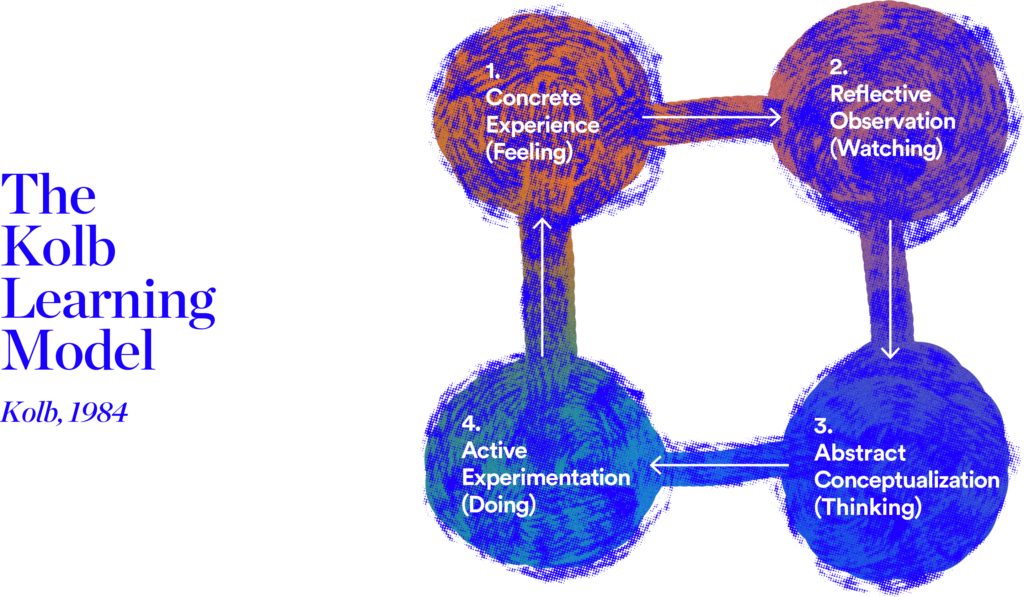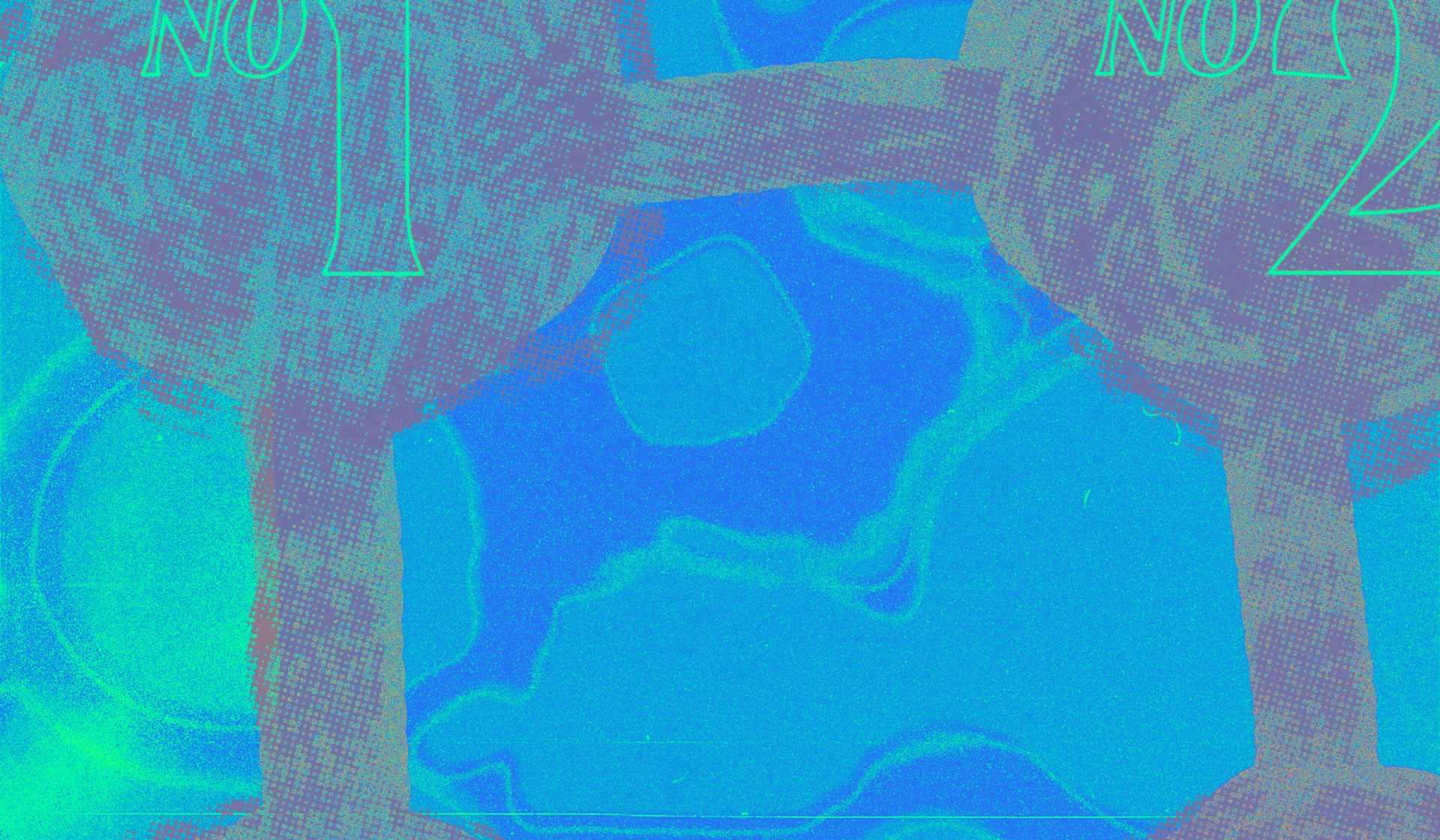Kolb’s Model is a tried and true framework used by L&D teams everywhere, and our team is no exception. At Maestro, we’ve spent many years with our team and clients discovering what makes a powerful learning experience, and from that, we’ve built an arsenal of learning philosophies and principles that guide the work we do in learning and development.
Kolb’s learning model has deeply influenced how we approach learning design. In this article, we’re going to detail Kolb’s model for experiential learning, or Kolb Method, and explore how it informs the learning process.
Kolb’s Model: The Experiential Learning Cycle
Kolb’s Model helps us answer the following question: How do learners absorb knowledge and actually apply it? We wholeheartedly believe that learning is a process, not a one-time event, and Kolb’s Model helps us break that process down.
Rarely are learners able to take one course, watch a single video, or read a book and suddenly be able to apply a concept perfectly. Instead, people learn in a cycle, moving through four distinct phases. This is the part of the David Kolb Learning Model known as The Experiential Learning Cycle.

First, we learn something new. Next, we think about what we’ve learned and different ways we’d like to apply it. Then, we take what we’ve learned and apply it in the real world. Finally, we reflect on the experience and figure out where we could improve. From there, the cycle repeats.
Now that we’ve covered a brief outline of Kolb’s Model, let’s look at our team’s updated take on the cycle and how it works.
David Kolb’s Learning Cycle stages
Traditionally, the Experiential Learning Cycle of Kolb’s Model contains the following stages:
- Concrete Experience
- Reflective Observation
- Abstract Conceptualization
- Active Experimentation
Though these phases are numbered, Kolb’s Model is a cycle where learners can start and end at any phase.
Kolb’s theory has informed a lot of our decisions when it comes to learning design. Through our learning and application of the model, we decided to modify it to define stages that are more clear, succinct, and actionable—creating a modern take on the Experiential Learning Cycle.
Learning Project Design Brief Template
This customizable learning program design template walks you through the key elements of a successful learning experience. As you begin planning your next learning project, consider the prompts on each slide as you fill in your responses. When you’re done, you’ll have a thorough and thoughtful brief to set your training and development programs up for success.
Our take on the stages of Kolb’s Model
1. Discover
Similar to the Concrete Experience phase in Kolb’s Model, this is the part of the process where the learner first experiences a concept or learns it. This can come in the form of watching a video, attending a training, reading a book, or interacting with the world around us. We call this the Discovery phase because it’s all about learning something new; it’s the start of the cycle and where the process of learning begins. In the “Tell, Show, Do, Review” blueprint for learning, this would overlap with the “Tell” phase.
2. Plan
Once a learner gains new knowledge, the next step is to reconcile that knowledge with their existing worldview and plan ways to apply that knowledge. This phase involves reflecting on the learning experience, reviewing what’s missing, and planning how to integrate new concepts in the real world.
Practically speaking, the Plan phase can be implemented into a course by processing and debriefing after introducing a new concept. This gives your learners the space to synthesize their knowledge and create a plan of action.
3. Apply
The Apply phase is similar to the Active Experimentation phase in Kolb’s Model. While all phases of the cycle are necessary, application is the most important. This is where concrete experience in experiential learning happens. It’s the phase that helps learning “stick” and shows learners where their knowledge gaps are. This phenomenon of application that exposes blind spots is also known as The Illusion of Explanatory Depth.
In learning development, an impactful application phase is perhaps the most critical part of the entire process: it’s where the rubber hits the road for learners. This phase is a great opportunity for learners to fail in a controlled environment through scenario learning or another form of immersive learning.
4. Reflect
In Kolb’s Abstract Conceptualization phase, the learner reflects in order to generate new ideas or modifications to what they’ve learned from their initial experience. In our Reflect phase, the learner reflects on their application experience and figures out where they need to grow before starting the cycle again.
Reflection can occur in an unstructured and independent way by encouraging learners to spend time thinking alone, in a structured and independent way through the use of journaling about an experience, or in a structured and social way through things like coaching or debriefing discussions. In the “Tell, Show, Do, Review” blueprint for learning, this phase overlaps with the “Review” stage.
Kolb Learning Styles
In addition to the Experiential Learning Cycle, David Kolb also developed learning styles to illustrate different ways people naturally take in information.
Kolb’s four learning styles are Diverging (feeling and watching), Assimilating (watching and thinking), Converging (doing and thinking), and Accommodating (doing and feeling). In Kolb’s theory, people tend to favor one of these four distinct styles, impacting how they learn.
While we deeply value David Kolb’s contribution to learning and the experiential learning cycle, we take a different stance on learning styles: we don’t believe that people only learn in these four ways. In contrast to Kolb, we believe all learners benefit from engaging with learning in multiple ways, and the best way to learn something is to have a holistic, well-rounded learning experience. Sure, learning preferences exist—but wholly subscribing to the idea of learning styles comes with many risks.
Applying Kolb’s Model in L&D
So, how does Kolb’s model help companies improve their learning? First, it gives you a proven framework for architecting effective experiences that take learners through every stage of the learning process. It also helps you avoid a “one-and-done” approach to learning. Because people rarely learn something after a single exposure, Kolb’s model helps companies adopt a more process-focused approach. A constant cycle of learning opportunities for your team members is what will make them, and by proxy the organization, the most successful.
There's more to learn about the foundations of effective learning design!
Access our on-demand webinar for free, 4 Key Principles to Inspire Change through Learning.
Watch it now→